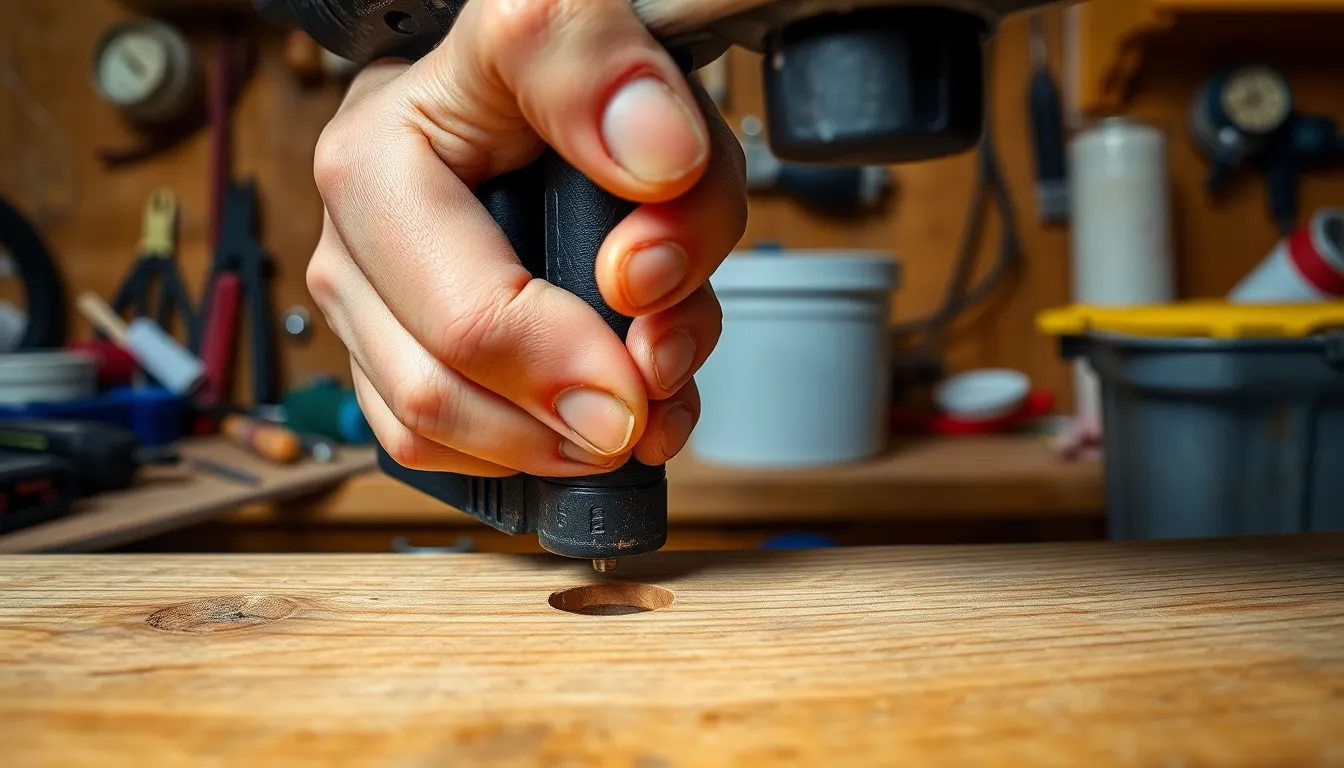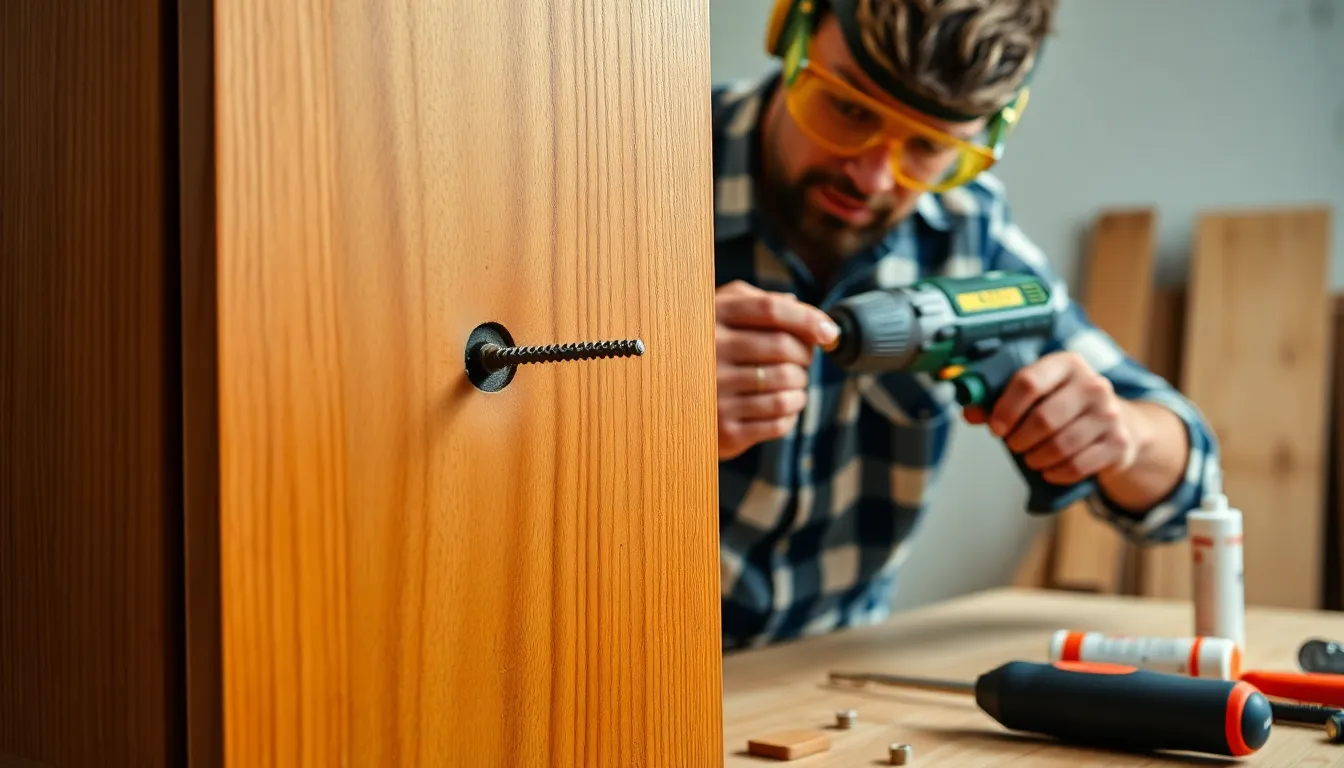Stripped screw holes can turn a simple project into a frustrating ordeal. Whether it’s a loose cabinet handle or a wobbly chair leg, these pesky problems often arise when screws lose their grip in wood or metal. Fortunately, fixing a stripped screw hole isn’t as daunting as it seems.
With a few handy techniques and tools, anyone can restore stability and functionality to their fixtures. From using wood filler to employing larger screws, there are various methods to tackle this common issue. Understanding the best approach can save time and money while ensuring a long-lasting fix. Let’s dive into the most effective solutions for repairing stripped screw holes and get your projects back on track.
Table of Contents
ToggleUnderstanding Stripped Screw Holes
Stripped screw holes occur when screws no longer grip tightly within their designated holes. This situation often arises due to over-tightening, wearing out the threads, or using the wrong screw size. Stripped holes lead to various issues, including loose fittings, unstable furniture parts, and ineffective repairs.
Common types of stripped screw holes include wood, metal, and plastic. Each type requires specific approaches for effective repair. For instance, wood holes may benefit from wood filler or larger screws, while metal holes might require Helicoil inserts or thread-forming screws. Understanding the material in which the screw hole exists is crucial for selecting the right repair method.
Several signs indicate a stripped screw hole. If a screw turns freely without resistance or fails to secure its position, a stripped hole likely exists. In addition, if screws continue to loosen despite repeated adjustments, it suggests a need for repair.
Addressing stripped screw holes promptly prevents further damage and enhances the longevity of furniture and fixtures. Choosing the correct repair technique not only restores grip but also ensures the structural integrity of the project.
Common Causes of Stripped Screw Holes

Stripped screw holes often arise from specific factors that compromise the integrity of the fastening system. Understanding these causes helps in preventing future occurrences and maintaining stable connections.
Improper Installation Techniques
Improper installation techniques frequently lead to stripped screw holes. Using excessive force during installation can damage the surrounding material, resulting in a weakened grip. Additionally, selecting the wrong screw size or type may prevent adequate engagement with the material. Ensuring that screws are aligned correctly before tightening also contributes to successful installations and minimizes the risk of stripping.
Wear and Tear Over Time
Wear and tear over time contributes significantly to the formation of stripped screw holes. Repeated use of screws can lead to thread degradation, causing the screws to fit loosely. Environmental factors, such as humidity and temperature fluctuations, exacerbate the wear process, especially in wooden materials. Regularly inspecting fasteners for signs of wear can help identify issues early, allowing for timely repairs and enhanced longevity of installations.
Tools and Materials Needed
Successful repair of stripped screw holes requires specific tools and materials designed to restore the integrity of the fittings. Below are the essential items for effective repairs.
Recommended Tools
- Screwdriver: A proper-sized screwdriver ensures optimal torque and minimizes damage to the screw head.
- Drill: A power drill aids in creating new holes or adjusting existing ones.
- Pliers: Pliers help to grip and remove any stubborn screws or debris.
- Tap and die set: This set enables the reinforcement of threads in metal applications, ensuring a secure fit.
- Auger bit: An auger bit facilitates drilling clean holes through wood for a precise fit.
Suitable Materials
- Wood filler: Ideal for wooden applications, wood filler repairs holes and creates a smooth surface for screw insertion.
- Epoxy: A strong adhesive, epoxy fills gaps and sets to create a durable, reinforced bond.
- Larger screws: Choosing a larger screw can help grip the surrounding material more effectively than the original.
- Dowels: Wooden dowels can replace the damaged area in wood screws, providing a fresh grip option.
- Plastic anchors: These anchors function well in drywall or plastic materials, offering stability for screws in soft materials.
Step-by-Step Guide on How to Fix a Stripped Screw Hole
Repairing a stripped screw hole can be straightforward with the right methods. Here are three effective techniques to restore functionality.
Method 1: Using Wood Glue and Toothpicks
- Clean the hole: Remove any debris from the stripped hole using a small brush or compressed air.
- Apply wood glue: Insert a small amount of wood glue into the hole to enhance bonding.
- Insert toothpicks: Take a couple of toothpicks and insert them into the hole. The toothpicks should fill the hole tightly. Break off the excess if necessary.
- Reinsert the screw: Allow the glue to dry per manufacturer instructions, then carefully drive the screw back into the hole. It should grip the toothpicks securely, restoring stability.
Method 2: Using a Helicoil Insert
- Drill the hole: Use an appropriately sized drill bit to widen the stripped hole according to the Helicoil insert specifications.
- Insert the Helicoil: Thread the Helicoil insert into the newly drilled hole. Use the installation tool included with the Helicoil kit, ensuring it’s flush with the surface.
- Secure the screw: Once the Helicoil is in place, insert the screw into the Helicoil. The specialized threads allow the screw to grip firmly and restore strength.
Method 3: Using Epoxy
- Clean the area: Ensure the stripped screw hole is free from dirt and grease. A clean surface promotes better adhesion.
- Mix epoxy: Prepare a suitable epoxy adhesive according to package directions. Achieve a uniform mixture for optimal bonding.
- Fill the hole: Apply the mixed epoxy into the stripped hole using a small tool, completely filling it.
- Set the screw: Insert the screw into the epoxy before it cures. Maintain the screw’s position until the epoxy hardens, ensuring it secures properly. Follow curing time guidelines on the epoxy package for best results.
Preventing Future Stripped Screw Holes
Preventing future stripped screw holes involves using appropriate techniques and materials during installation.
- Choose the Right Screw Size: Select screws that match the size and type of the material. Overly large or small screws increase the likelihood of stripping.
- Use Proper Torque: Apply the correct amount of torque while tightening screws. Over-tightening can damage threads, leading to stripped holes.
- Incorporate Washers: Install flat washers under screw heads to distribute weight evenly. This additional surface area reduces pressure on the material, minimizing damage.
- Inspect for Damage: Regularly check screws and holes for signs of wear. Detecting issues early allows for timely repairs before they worsen.
- Utilize Pilot Holes: Drilling pilot holes before inserting screws helps guide them properly and reduces the risk of splitting or stripping.
- Opt for Durable Materials: Use high-quality screws and fillers designed for specific applications. Superior materials enhance longevity and support.
- Limit Environmental Impact: Control exposure to excessive moisture or temperature fluctuations. This helps maintain the integrity of screws and holes over time.
- Employ Correct Installation Techniques: Follow guidelines for mounting and installing hardware. Ensuring proper procedures reduces the risks associated with stripped holes.
By integrating these practices, one can effectively minimize the occurrence of stripped screw holes in future projects.
Repairing stripped screw holes is a straightforward task that can significantly enhance the stability of furniture and fixtures. By utilizing the right techniques and tools, anyone can tackle this common issue effectively. Whether it’s using wood filler, larger screws, or specialized inserts, each method offers a reliable solution tailored to specific materials.
Taking preventive measures is equally important. Regularly inspecting screws and ensuring proper installation techniques can minimize future problems. By staying proactive, individuals can maintain the integrity of their projects and enjoy lasting results. With these strategies in hand, fixing stripped screw holes becomes a manageable and rewarding endeavor.




